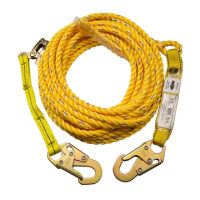9
Safety Information
WARNING! Failure to understand and
comply with safety regulations may result
in serious injury or death. Regulations
included herein are not all-inclusive, are
for reference only, and are not intended to
replace a Competent Person’s judgment or
knowledge of federal or state standards.
Do not alter equipment. Do not misuse
equipment.
Workplace conditions, including, but not
limited to, flame, corrosive chemicals,
electrical shock, sharp objects, machinery,
abrasive substances, weather conditions,
and uneven surfaces, must be assessed by
a Competent Person before fall protection
equipment is selected.
The analysis of the workplace must
anticipate where workers will be performing
their duties, the routes they will take to
reach their work, and the potential and
existing fall hazards they may be exposed
to. Fall protection equipment must be
chosen by a Competent Person. Selections
must account for all potential hazardous
workplace conditions. All fall protection
equipment should be purchased new and
in an unused condition.
Fall protection systems must be selected
and installed under the supervision of a
Competent Person, and used in a compliant
manner. Fall protection systems must
be designed in a manner compliant with
all federal, state, and safety regulations.
Forces applied to anchors must be
calculated by a Competent Person.
Unless explicitly stated otherwise, the
maximum allowable free fall distance for
lanyards must not exceed 6’. No free fall
allowed for non-LE SRLs. Class A SRLs
must arrest falls within 24”; Class B SRLs
must arrest falls within 54”.
Harnesses and connectors selected
must be compliant with manufacturer’s
instructions, and must be of compatible
size and configuration. Snap hooks,
carabiners, and other connectors must
be selected and applied in a compatible
fashion. All risk of disengagement must be
eliminated. All snap hooks and carabiners
must be self-locking and self-closing, and
must never be connected to each other.
A pre-planned rescue procedure in the case
of a fall is required. The rescue plan must
be project-specific. The rescue plan must
allow for employees to rescue themselves,
or provide an alternative means for their
prompt rescue. Store rescue equipment
in an easily accessible and clearly marked
area.
Training of Authorized Persons to correctly
erect, disassemble, inspect, maintain,
store, and use equipment must be provided
by a Competent Person. Training must
include the ability to recognize fall hazards,
minimize the likelihood of fall hazards,
and the correct use of personal fall arrest
systems.
NEVER use fall protection equipment of
any kind to hang, lift, support, or hoist tools
or equipment, unless explicitly certified for
such use.
Equipment subjected to forces of fall arrest
must immediately be removed from use.
Age, fitness, and health conditions can
seriously aect the worker should a fall
occur. Consult a doctor if there is any reason
to doubt a user’s ability to withstand and
safely absorb fall arrest forces or perform
set-up of equipment. Pregnant women and
minors must not use this equipment.
Physical harm may still occur even if fall
safety equipment functions correctly.
Sustained post-fall suspension may result
in serious injury or death. Use trauma relief
straps to reduce the eects of suspension
trauma.

